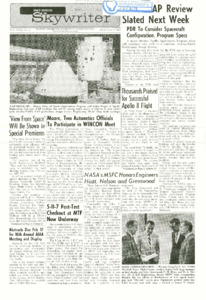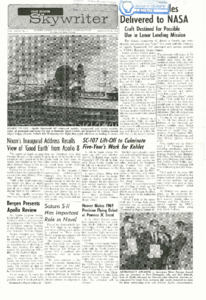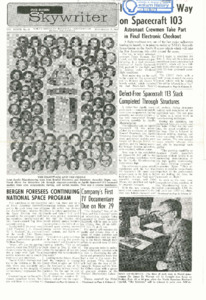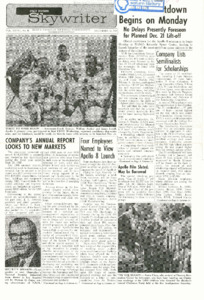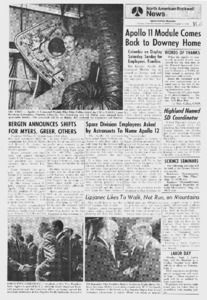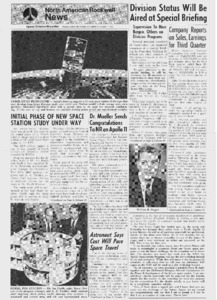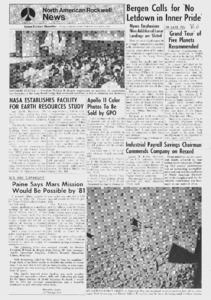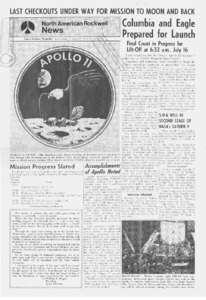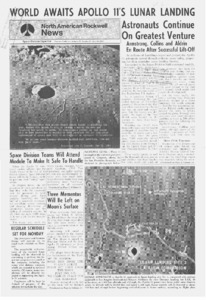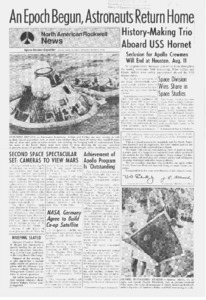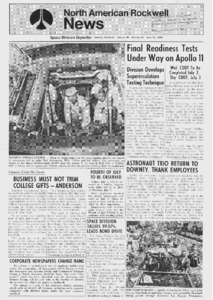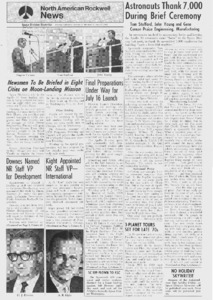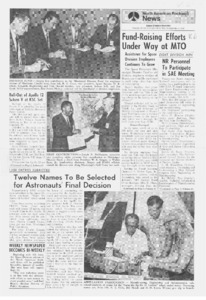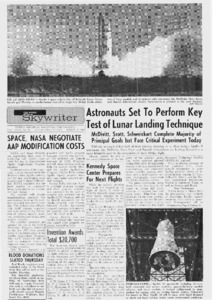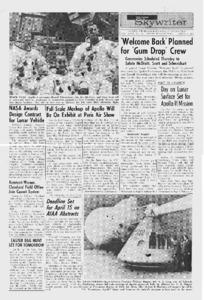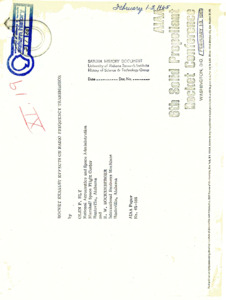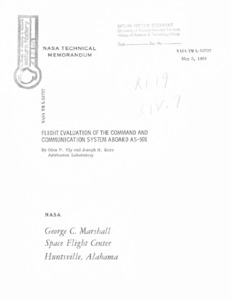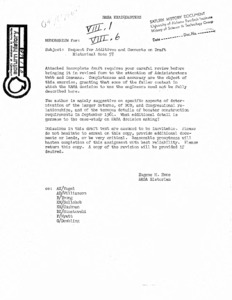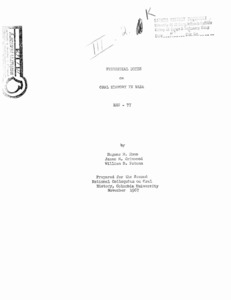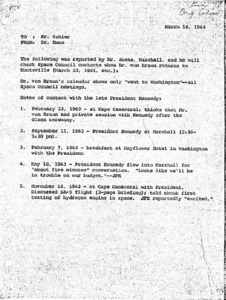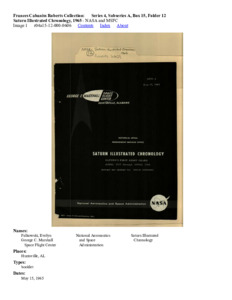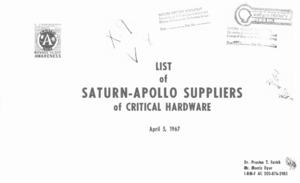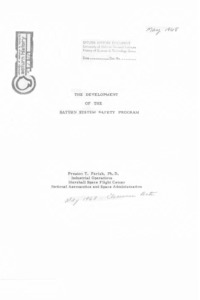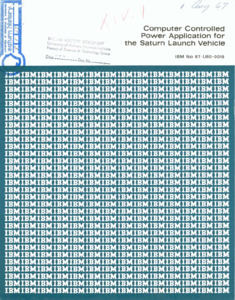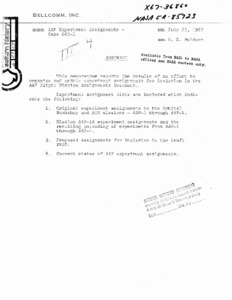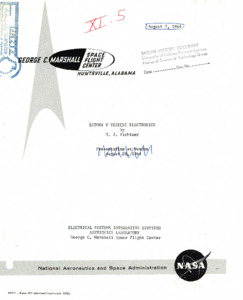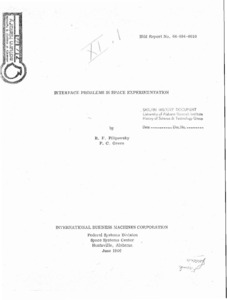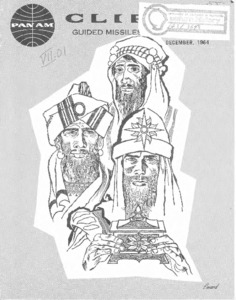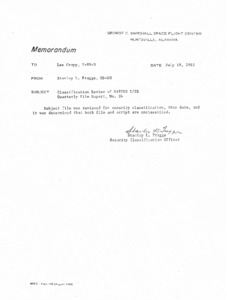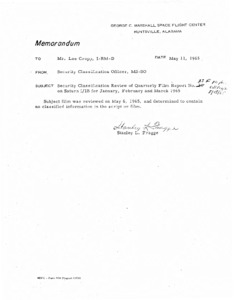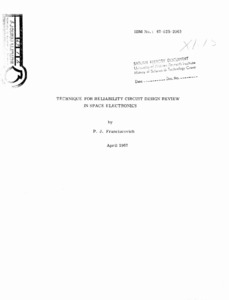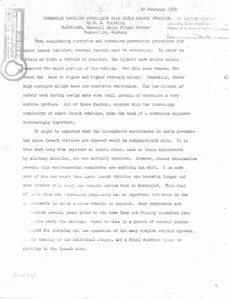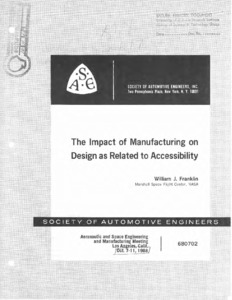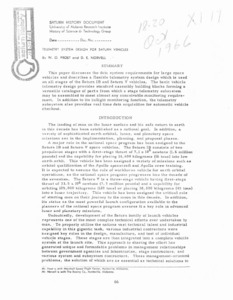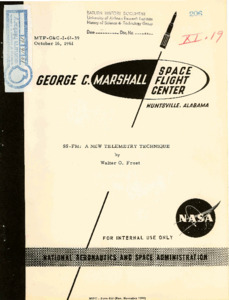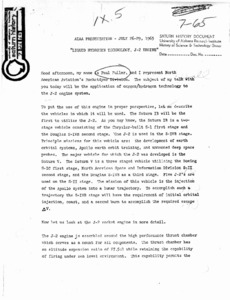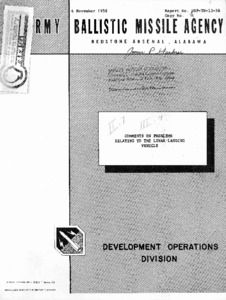
Browse Items (716 total)
Sort by:
-
"AAP review slated next week."
News article detailing the purpose of the PDR, that being to review the APP's configuration and program plans and technical specifications. -
"Craft destined for use in lunar landing mission."
News article detailing how the Apollo spacecraft 107 command modules are planned to be used in future space-missions. -
"Astronaut crewmen take part in final electronic checkout."
News article detailing the final tests leading up to the launch of the Apollo 103. -
"Apollo countdown begins on Monday."
News article detailing the interest around the liftoff of the Apollo 8 spacecraft. -
"Apollo 11 module comes back to downey home."
A news article detailing the return of the Apollo 11 module to Downey and the plans to set it up as a display. -
"Initial phase of new space station study are underway."
A news article detailing the new space station project. -
"Hundreds of Apollo employees submit Apollo names."
A news article detailing a program for Apollo staff to name command modules. -
"NASA establishes facility for Earth resources study."
A news article detailing the new facility NASA constructed, touching on the project its meant for. -
"Columbia and eagle prepared for launch."
A news article detailing the scheduled launch for the Apollo 11. "Eagle" is the name of the lunar module and "Columbia" is the name of the service module. -
"Astronauts continue on greatest venture."
A news article detailing the progression of the Apollo 11 mission and its preparation for a moon-landing. -
"History-making trio aboard USS Hornet."
A news article detailing the recovery of the Apollo 11 crew by the USS Hornet. -
"Final readiness test underway on Apollo 11."
A news article detailing the final preparation and readiness tests for the Apollo 11 rocket and crew. -
"Astronauts thank 7,000 during brief ceremony."
A news article detailing a ceremony in which astronauts thank the crew who built their rocket. -
"North American Rockwell News: Space Division Skywriter: Volume 29 Number 37."
An entire newspaper containing a number of articles both related and not related to the Saturn program. -
"Astronauts set to preform key test of lunar landing technique."
News article detailing an experiment revolving around taking photographs from a high altitude to observe the Earth's surface. -
"Welcome back planned for 'Gum drop' crew."
News article detailing the planned 'Welcome back' events surrounding the resturn of the Apollo 9 crew. -
"Rocket exhaust effects on radio frequency transmission."
Presented by Olen P. Ely, National Aeronautics and Space Administration, Marshall Space Flight Center, Huntsville, Alabama and R. W. Hockenberger, International Business Machines. Paper that explores the effects of rocket-engine exhaust on radio-signals. -
"Flight Evaluation of the Command and Communication System Aboard AS-501."
The first test of the command and communications system, a unified frequency S-band system, aboard AS-501 was successful. Compatibility of this system with the MSFN/USB sites was established. The onboard transponder and antenna system including antenna switching performed as predicted. The command performance was excellent with 5747 valid commands received onboard out of 5748 commands transmitted. Data reduction problems prevented a complete analysis of the tracking data. Telemetry system performance was satisfactory with a measured bit-error-rate of 4 x10-5 while over the Ascension Island station. This flight provided valuable data which can be used to define vehicle to-ground-station interfaces, to establish attitude constraints during translunar injection, and to improve operational procedures. One more test as successful as the AS-501 test would qualify the system as operational.; May 3,1968. -
"Memorandum : request for additives and comments on draft historical note 57."
Memorandum requesting for comments on historical draft note. -
"Historical Notes on Oral History in NASA."
Prepared for the Second National Colloquium on Oral History, Columbia University. Contains notes on the oral history of NASA. -
"Report to Mr. Sohier from Dr. Emme."
Report detailing dates of Dr. Akens Marshall meetings with President Kennedy. -
Saturn Illustrated Chronology, 1965
NASA and MSFC -
"List of Saturn-Apollo Suppliers of Critical Hardware."
A list of critical hardware from Saturn-Apollo Suppliers. -
"The development of the Saturn system safety program."
This paper describes the major highlights or milestones passed in the development of a System Safety Program at MSFC since early 1967. it discusses accomplishments, problems resolved, and decisions made for Apollo Saturn vehicles AS-501 and AS-502, and projects that are to be accomplished on future Saturn vehicles. -
"Computer Controlled Power Application for the Saturn Launch Vehicle".
This paper describes a real-time digital computer program that controls the application of electrical power to the S-IVB stage of the Saturn vehicle at Cape Kennedy, Florida. Douglas Aircraft Company, the S-IVB stage manufacturer, provided NASA with the program requirements relative to the energizing sequence, voltage and current measurement tolerances, and vehicle system operational tests. International Business Machines Corporation provided NASA with the computer program to satisfy the task requirements. The program conjoined the components of the Electrical Support Equipment (two RCA 110A computers and control and instrumentation devices) into a closed loop system. The supporting operating system program by IBM is described. -
"Memorandum : AAP experiment assignments - Case 600-1."
This memorandum reports the results of an effort to organize and update experiment assignments for inclusion in the AAP Flight Mission Assignments Document. Experiment assignment lists are included which indicate the following: 1) Original experiment assignments to the Orbital Workshop and ATM missions - AAP-1 through AAP-4; 2) Mission AAP-1A experiment assignments and the resulting unloading of experiments from AAP-1 through AAP-4; 3) Proposed assignments for inclusion in the draft FMAD; 4) Current status of the AAP experiment assignments.; X67-36860.; NASA TR - 85723. -
"Saturn V vehicle electronics."
This presentation is a review of the electrical and electronics systems of the Saturn V launch vehicle. Since airborne and ground electronics cannot be separated as a system, this presentation will touch upon both the airborne and ground checkout equipment. Certain airborne electronic items are singled out in order to elaborate upon the application of computers for checkout and launch. This review covered in a broad sense such airborne electronics as the control computer, the measuring telemetry and RF systems, the switch selector, the digital command receiver and the remote automatic calibration system. The ground support equipment electronics covered include such equipment as the data link, computer system and display systems. The importance of software in the Saturn V program is stressed by the application of a standard program language through the use of acceptance test or launch language (ATOLL). -
"Saturn V vehicle electronics."
This presentation is a review of the electrical and electronics systems of the Saturn V launch vehicle. Since airborne and ground electronics cannot be separated as a system, this presentation will touch upon both the airborne and ground checkout equipment. Certain airborne electronic items are singled out in order to elaborate upon the application of computers for checkout and launch. This review covered in a broad sense such airborne electronics as the control computer, the measuring telemetry and RF systems, the switch selector, the digital command receiver and the remote automatic calibration system. The ground support equipment electronics covered include such equipment as the data link, computer system and display systems. The importance of software in the Saturn V program is stressed by the application of a standard program language through the use of acceptance test or launch language (ATOLL). -
"Interface Problems in Space Experimentation."
Space experimentation is expanding rapidly. Unmanned satellites are being equipped with precision instruments of greater power, and manned space stations accommodating large crews are in the drawing-board stage. The interface problems between these sophisticated instruments and between man, the spacecraft, and the supporting groundstations are multidimensional. This paper analyzes the scientific/technical areas of space experimentation, and continues with a review of the subsystems and support systems required to supply and operate the large variety of instruments. Areas of major integration efforts are singled out and the requirements for further developments and improvements are listed. A bibliography of 95 references is enclosed to assist in the identification of more detailed reports on all vital aspects of space experimentation.; Archive copy is a photocopy.; Supplement to IEEE Transactions on Aerospace and Electronic Systems, Vol. AES-2, No. 4, July, 1966. Pages 237 to 255. -
"Pan Am Clipper : Guided Missiles Range Division : December, 1964."
A collection of articles, one of which musing about the landing on/colonization of Mars in the future. -
"Classification review of Saturn I/IB quarterly film report, no. 24."
Memo to Lee Cropp, I-RM-D concerning security classification. -
"Security classification review of quarterly film report no. 23."
Memo to Mr. Lee Cropp indicating that 'the film' had been reviewed and was deemed to contain no classified information. -
"Technique for reliability circuit design review in space electronics."
Design review is becoming a basic requirement during the design and development of military systems. The main purpose of the design review is to increase the system's inherent and operational reliability. The major portion of this paper is the result of reliability's effort to comply with Paragraph 3.6 of NPC 250-1 Reliability Program Provisions for Space Contractors. The design review to be discussed is a reliability circuit design review with emphasis placed on what should be reviewed and the review techniques employed. The basic circuit design review prerequisites, component parts and their ratings, are discussed at the beginning of this paper. The remainder deals with the organization and reviewing of circuits. The review items include worst-case circuit performance, component applications, failure mode analysis, noise rejection, electrical stress, and the determination of component temperatures. Many examples are included to illustrate how each item was accomplished. This paper is intended not only to give the reliability analyst cognizance of basic design problems and troublesome circuits, but also, to aid him in formulating a design review program. -
"Corrosion Problems Associated with Space Launch Vehicles".
A document reporting various space vehicle corrosion issues. Original is photocopy. -
"The impact of manufacturing on design as related to accessibility."
The purpose of this paper is to emphasize the need for accessibility in the assembly and maintenance of spacecraft. This is especially pertinent because accessibility to subsystems for replacement, repair, and maintenance has proven to be one of the more costly phases of preflight preparation. The most successful programs in this day and age have been when the design and manufacturing engineers work side by side around a mockup where solutions to the problems can be visually seen and solved, keeping in mind the assembly as related to accessibility. Therefore, it will be shown that in order to overcome the difficulties, designers should adapt a hard, fast ground rule that each unit must be accessible and individually removable without disturbing the other units.; Aeronautic and Space Engineering and Manufacturing Meeting, Los Angeles, Calif. Oct. 7 - 11, 1968. -
"Telemetry system design for Saturn vehicles."
This paper discusses the data system requirements for large space vehicles and describes a flexible telemetry system design which is used on all stages of the Saturn IB and Saturn V vehicles. The basic vehicle telemetry design provides standard assembly building blocks forming a versatile catalogue of parts from which a stage telemetry subsystem may be assembled to meet almost any conceivable monitoring requirement. In addition to its inflight monitoring function, the telemetry subsystem also provides real time data acquisition for automatic vehicle checkout. -
"A new telemetry technique."
A technique new to telemetry is discussed which promises to alleviate an enigma facing the telemetry engineer : How to adequately transmit the avalanche of vibration and other wideband data desired in the development phase of large missiles and launch vehicles. The data channels are stacked in the frequency spectrum as single sideband subcarriers which frequency modulate the RF carrier. The system design utilizes to advantage the statistical properties of vibration data to achieve maximum data transmission efficiency from the available RF carrier deviation. However, in contrast to proposed statistical predigestion techniques, the data is transmitted in raw form. -
"Liquid Hydrogen Technology, J-2 Engine."
subject of the speech is the application of oxygen/hydrogen technology the 5-2 engine system. -
"Comments on Problems Relating to the Lunar-Landing Vehicle."
"This technical note concerns some of the problems encountered with the landing of a payload on the moon. The main problem areas such as guidance, velocity control and impact considerations are discussed. Although no final conclusions or designs are intended, it is hoped that the material presented will serve as a guide for future detailed work."
